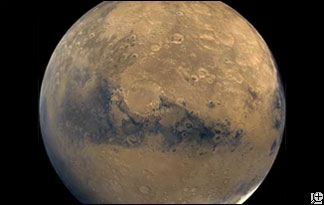
© Discovery News
Before they brought destruction, a series of huge asteroids orbiting Mars four billion years ago may have sparked its magnetic field, giving the planet its greatest chance for harboring life.
Mars has no magnetic field today. Cosmic radiation ravages its atmosphere and surface, a big reason why it is thought to be inhospitable to life. But between 4.5 and 4.0 billion years ago, its core of liquid iron and rock churned with intense heat, creating a dynamo that raised a protective magnetic force field around the planet.
Then the magnetic field abruptly disappeared, and no one knows why.
Jafar Arkani-Hamed of the University of Toronto thinks the field could've been powered by between one and four huge asteroids captured in Mars' orbit. About one percent the size of Earth's moon, any one of the enormous rocks would have had sufficient gravity to tug on Mars' core, causing enough convection to create a magnetic dynamo.
"Theoretically, a retrograde orbiting, captured asteroid can produce a dynamo in the planet," Arkani-Hamed said. "If our moon orbited against Earth's rotation instead of with it, it could've have excited the dynamo here."
The asteroids' orbits would've been unstable, though, and their stints as moons short-lived. After spiraling ever closer to Mars for 500 million years, they would've shattered into several fragments before slamming into the planet. Without their immense pull to keep the dynamo going, Mars' magnetic field would have quickly shut down.
If Arkani-Hamed's theory is right, that would mean some of the 20 or so giant impact basins on Mars were formed when a few huge asteroids broke into pieces before landing in a fiery salvo. Many of the basins are scattered in arc-shaped patterns across the planet, each cluster suggesting that several rocks all traveled in the same orbital path, and may have once been one solid mass.
"I don't think it's a crazy idea," Francis Nimmo of the University of California Santa Cruz, "but the problem you run into is one of duration."
Phobos, one of Mars' two present-day moons, is also destined for impact. Arkani-Hamed's theory requires the giant asteroids of antiquity to power the dynamo for 500 million years before finally crashing home. Phobos only has about 50 million years before it hits.
Nimmo also noted that not all of the basins in each arc match up in age, making it tough to argue that the cluster came from the same original giant rock.

Reader Comments
to our Newsletter